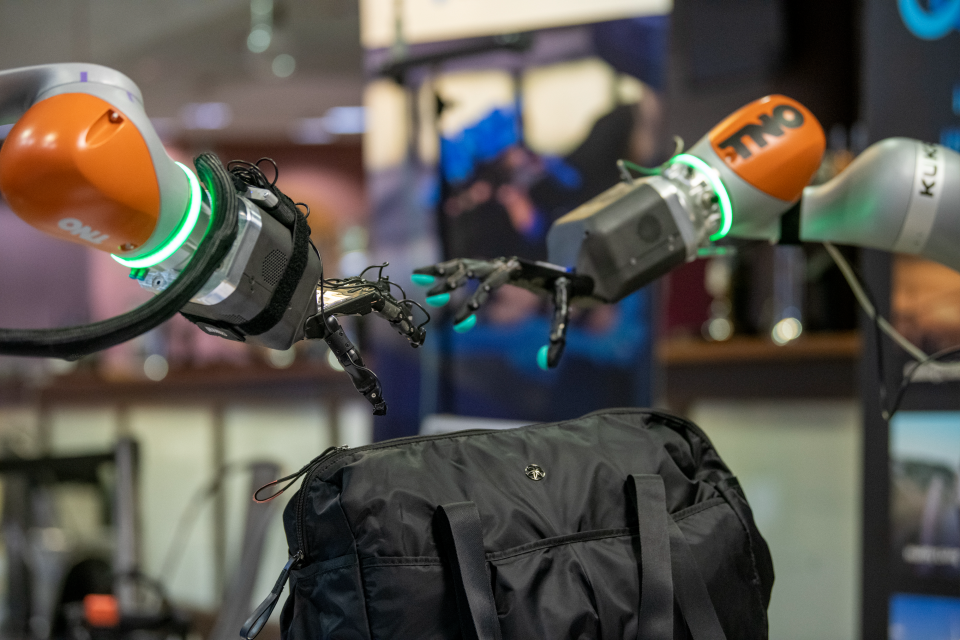Defence Science and Technology Laboratory
|
|
Dstl grasps telexistence potential to reduce risk to personnel
At a recent event, suppliers demonstrated an array of technologies that allow an operator to experience being in a distant location.
The Defence Science and Technology Laboratory (Dstl) has demonstrated innovative telexistence concepts that could give military personnel, emergency services, or humanitarian workers the capability to undertake dangerous tasks in hazardous environments without physically being present.
An array of different technologies were displayed by industry suppliers to potential military and government users at a presentation event organised by the Defence and Security Accelerator (DASA) in October and co-funded by the Nuclear Decommissioning Authority (NDA).
Telexistence combines 3 separate technologies to allow a user to experience being in a location many miles away as if they were there along with the ability to sense, touch, feel, and interact with objects. This is achieved using a remotely-operated system, and relies on the integration of:
- telepresence, which enables the operator to see and hear as though in the remote environment
- robotics or wearable assistive technologies, which enable the operator to interact with the remote environment
- haptic feedback or sensors which enable the operator to touch and feel the remote environment
Telexistence offers a future generation of technology to mitigate the human risk associated with operating in hazardous environments by removing personnel from dangerous areas. Examples include:
- explosive ordnance disposal (EOD)
- nuclear decommissioning
- casualty extraction
- fire scene investigation
- chemical, biological, radiological, disaster response and decontamination
- ocean floor and naval damage exploration
- space exploration
As well as reducing risk, telexistence has the potential to reduce logistical burden and increase the speed that users can be deployed. This would offer advantages to capabilities where there are a limited number of specialists, such as EOD, telemedicine and training. Telexistence would allow these specialists to support several operations as and when needed, rather than being deployed to a specific operation in case their skills are required.


Pictured: the 'Haptic Bimanual Telexistence System' or HaBiTS technology project developed by Netherlands Organisation for applied scientific research (TNO) and SenseGlove demonstrating an EOD inspired scenario in which an operator is able to open an ‘unattended’ bag delicately and remotely using the zipper through a haptic bimanual telemanipulation setup (a remotely operated pair of robot hands and arms) in a telepresence context.
Dr Nicky Armstrong, Dstl’s technical lead, yesterday said:
The project aims to help us understand where telexistence may improve defence capabilities, shaping user requirements to influence future technology development. By exploiting the technology early, we will grasp the possibilities and limitations of the concept, enabling us to identify and rectify gaps that would hinder its adoption.
Lt Col Gareth Walker, a Dstl Military Adviser, yesterday said:
The event was a great example of industry and the UK’s armed forces working in partnership to help solve our future challenges. Through the demonstration of emerging technology and sharing of experiences, we have taken the first steps required to accelerate these novel and innovative ideas into battle-winning capabilities.
Jen Mcara, DASA Associate Delivery Manager, added:
It was fantastic to see the prototypes in action after all the hard work and development by the suppliers. Seeing the technology first hand, gives potential military and government users a real feel for how the innovations could help them tackle a range of defence and security challenges from a safe distance. This collaboration between Dstl, NDA and innovators is a key part of DASA’s work to pull through next generation defence technology.
Companies involved in the DASA competition were L3 Harris, Teleman, Cyberselves Holoxica, Createc, Digital Kinematics, Centric, Netherlands Organisation for applied scientific research (TNO), Cyberselves and Createc.
Brexit
Original article link: https://www.gov.uk/government/news/dstl-grasps-telexistence-potential-to-reduce-risk-to-personnel


.png)